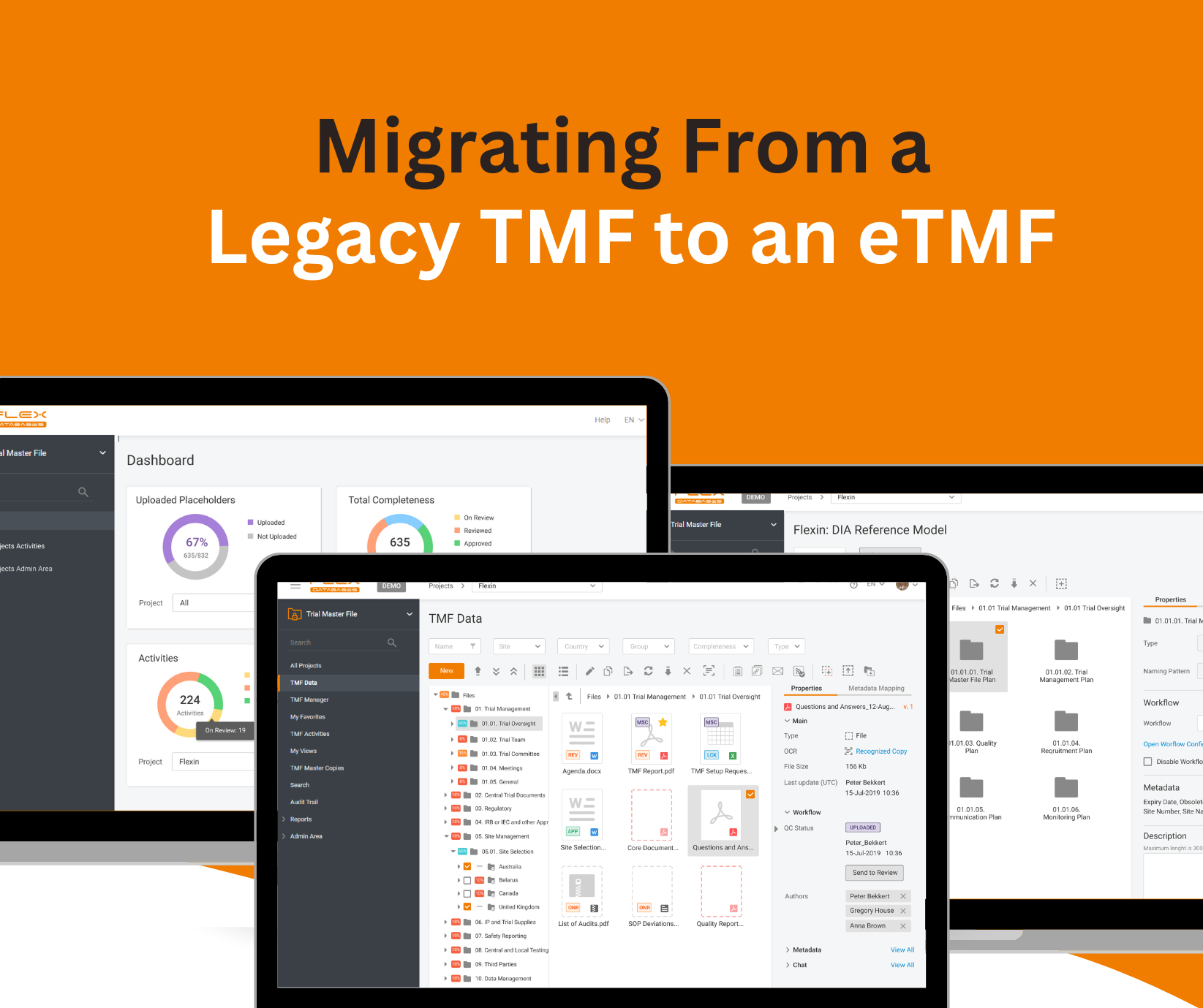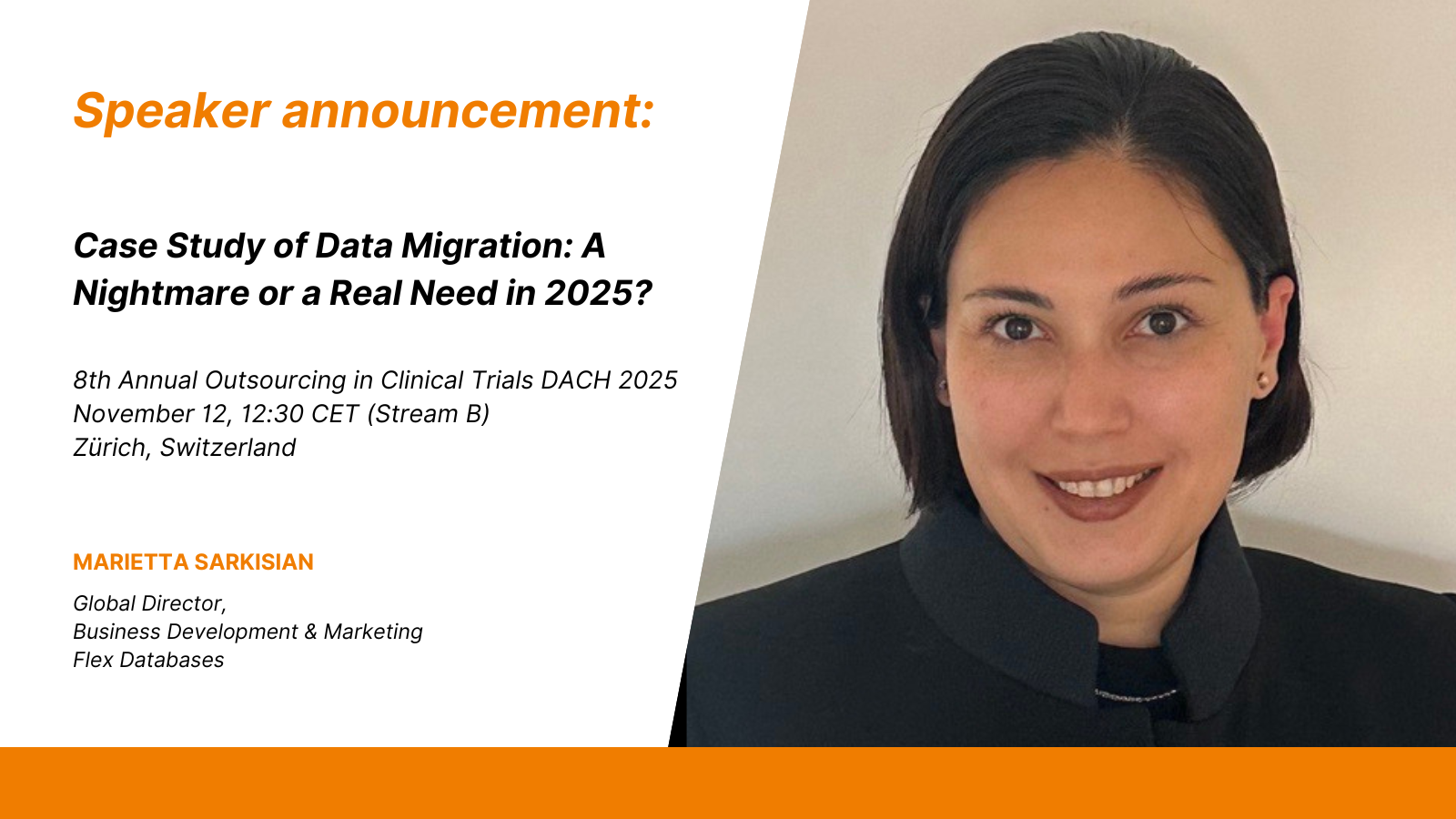Checklist: Migrating from a Legacy TMF to an eTMF
June 19, 2025

Many clinical trial teams still rely on a legacy TMF – whether that means physical binders or outdated digital folders lacking structure and traceability. These systems often fall short in today’s increasingly regulated, fast-paced environment, making oversight and compliance more difficult.
That’s why more sponsors and CROs are transitioning to a modern eTMF. A modern eTMF provides centralized access, built-in audit trails, and real-time collaboration – making it easier to stay inspection-ready and compliant with GCP and ICH E6(R3) guidelines. Beyond compliance, a modern eTMF helps improve team efficiency and minimizes the risk of lost or misfiled documents.
This article offers a step-by-step checklist to help you successfully migrate from a legacy TMF to a modern eTMF, with a focus on planning, execution, and post-migration quality control.
Why Migrate from Legacy TMF to a Modern eTMF?
The transition from a legacy TMF to a modern eTMF is driven by both regulatory and operational imperatives. Regulatory frameworks such as ICH E6(R3) and Good Clinical Practice (GCP) emphasize the need for robust documentation systems that ensure completeness, contemporaneity, and auditability of essential clinical trial records. Paper-based or fragmented digital systems struggle to meet these evolving expectations, especially as regulatory inspections become more rigorous and technology-driven.
A modern eTMF system offers a number of significant benefits that directly address the shortcomings of a legacy TMF:
- Centralized, real-time access
A modern eTMF enables all stakeholders – regardless of location – to access up-to-date documents in a secure, cloud-based environment. This improves collaboration across sites, sponsors, and CROs, while reducing delays in document availability and approvals. - Automated audit trails
Regulatory agencies increasingly expect clear traceability of document actions. Modern eTMFs maintain detailed audit trails automatically, recording who accessed, edited, or moved a document—eliminating manual tracking and enhancing compliance. - Inspection readiness
A disorganized legacy TMF can lead to delays or findings during regulatory inspections. In contrast, a modern eTMF supports ongoing inspection readiness by structuring documents according to industry standards (e.g., DIA Reference Model) and offering real-time dashboards to identify gaps or missing files. - Reduced human error
Automation of filing rules, metadata capture, and version control in modern eTMFs significantly reduces the chance of misfiled, duplicate, or outdated documents – a common issue in legacy TMF systems reliant on manual processes. - Interoperability with other eClinical systems
A key advantage of modern eTMFs is their ability to integrate with other platforms such as CTMS, EDC, and safety databases via APIs. This enables automated document generation, synchronized data fields, and fewer manual touchpoints, ultimately leading to greater efficiency and fewer compliance risks.
In sum, moving away from a legacy TMF toward a modern eTMF is not just a technical upgrade – it is a strategic shift that supports regulatory alignment, operational scalability, and long-term digital transformation in clinical trials.
Migration Preparation Checklist
Successful migration from a legacy TMF to a modern eTMF begins long before the first document is moved. A thorough preparation phase lays the foundation for compliance, data integrity, and long-term usability of the new system. The following checklist outlines critical steps to take before initiating the migration:
Define migration goals and scope
Clarify the purpose of the migration. Are you seeking improved compliance, inspection readiness, or operational efficiency? Define whether the migration includes all historical studies, ongoing trials, or only essential documents. Establish clear timelines, success criteria, and performance indicators.
Assign a cross-functional migration team
Assemble a dedicated team with representatives from Quality Assurance, Clinical Operations, IT, and the designated TMF owner. A cross-functional approach ensures all regulatory, technical, and process-specific aspects of the migration are addressed from the outset.
Assess the current state of your TMF
Conduct a comprehensive audit of your legacy TMF, identifying gaps, missing documents, duplicates, or non-compliant files. This assessment helps quantify the migration effort and uncovers issues that may need resolution prior to transfer.
Identify documents to be migrated
Define the set of documents eligible for migration. This includes essential documents required by ICH-GCP, as well as superseded versions if regulatory or internal policies require version retention. Decide whether supporting documents or archived materials will be included.
Define metadata requirements and indexing structure
One of the key differences between a legacy TMF and a modern eTMF is the use of structured metadata for searchability, classification, and audit readiness. Map metadata fields to the new eTMF structure, aligning with the DIA TMF Reference Model or your organization’s filing plan.
Select your eTMF vendor
Choose a vendor that not only meets your compliance and functionality needs but also supports migration services and integrations with other systems (e.g., CTMS or EDC). Evaluate vendor experience in handling complex migrations and ensure appropriate data validation protocols are in place.
Conduct a risk assessment and develop a mitigation plan
Identify potential risks such as data loss, incomplete transfers, or misalignment of metadata during the migration process. Create a mitigation strategy that includes testing protocols, fallback plans, validation checkpoints, and communication strategies to manage disruptions.
Data Cleaning & Classification
One of the most critical phases of legacy TMF migration is ensuring the quality, completeness, and consistency of the documents to be transferred. Poorly organized or non-compliant files can undermine the value of the new eTMF system and pose risks during inspections. This stage involves a methodical review and standardization process to prepare content for a clean and compliant transfer.
Remove duplicates and outdated documents
Redundant or obsolete documents—common in legacy TMF environments—must be identified and removed. This helps reduce storage costs, eliminates confusion during audits, and ensures that only the most relevant, accurate records are carried forward.
Ensure documents are complete and properly labeled
Incomplete documents or those missing critical information (e.g., signatures, dates, or context) must be addressed before migration. Each file should be reviewed for completeness and accurately labeled to match the future eTMF’s taxonomy and metadata schema.
Verify compliance with ALCOA+ principles
As part of legacy TMF migration, each document must meet ALCOA+ criteria—Attributable, Legible, Contemporaneous, Original, Accurate, plus Complete, Consistent, Enduring, and Available. Ensuring these standards are met before migration prevents regulatory noncompliance later.
Standardize naming conventions, metadata, and file formats
Legacy systems often lack consistent naming rules or metadata tagging. Migrating to a modern eTMF requires standardized document titles, file formats (e.g., PDF/A), and harmonized metadata fields in alignment with the DIA TMF Reference Model or internal SOPs.
Validate document versioning
Ensure that only the correct versions of documents are migrated and that version histories are retained when required. Version control must be accurate and transparent to ensure regulatory defensibility and proper document lifecycle management in the eTMF.
Proper data cleaning and classification not only streamlines the legacy TMF migration process but also sets the foundation for efficient document retrieval, regulatory inspection readiness, and overall data integrity in the new eTMF system.
Legacy TMF Migration Execution
The execution phase of a TMF migration involves the technical transfer of content from the legacy system to the new eTMF platform. A carefully controlled migration process is essential to preserve data integrity, maintain regulatory compliance, and avoid delays in ongoing clinical operations.
Choose the right migration method: manual upload vs. automated import
Depending on the volume and complexity of documents, TMF migration can be performed manually or through automated tools. Manual uploads may suit smaller, well-organized datasets, while automated import processes are more efficient for large-scale migrations. The chosen method should align with available resources, timelines, and validation requirements.
Perform a pilot migration with a subset of documents
Before full-scale implementation, a pilot migration using a representative subset of documents is strongly recommended. This test run allows teams to evaluate system performance, check metadata mapping, and detect potential errors in document structure or indexing.
Validate migrated data
Post-migration validation is a critical step in ensuring that every document has been accurately transferred. This includes verifying document presence, metadata accuracy, and adherence to filing conventions. Validation should be conducted against a predefined acceptance checklist.
Document all processes for audit readiness
Regulatory bodies expect evidence of control during any system transition. Throughout the TMF migration, all steps—from planning and risk assessment to execution and validation—should be documented in detail. These records may be subject to inspection and should demonstrate compliance with GCP and internal SOPs.
Lock legacy TMF version and archive if required
Once the new eTMF system is validated and in use, the final version of the legacy TMF should be locked and archived. This ensures a clear separation between historical records and current operations, and provides a fallback reference in case of discrepancies.
Post-Migration Activities
Completing the TMF migration marks the beginning of a new operational phase. To ensure long-term success and sustainability, several post-migration actions should be taken to optimize adoption, governance, and compliance.
Conduct user training on the new eTMF system
A modern eTMF may introduce new workflows, terminology, or interfaces. Comprehensive training sessions should be delivered to all users to ensure effective system adoption, reduce errors, and promote consistent document handling practices.
Define SOPs for future document handling
Update or create standard operating procedures (SOPs) that reflect the capabilities and expectations of the new eTMF. These should cover document creation, review, filing, versioning, and quality control to maintain consistency and regulatory compliance.
Run internal quality checks and audits
After the TMF migration, internal audits and spot checks can help detect any residual issues such as misfiled documents or missing metadata. These checks build confidence in the new system’s readiness for external inspection.
Ensure ongoing compliance monitoring
A modern eTMF enables proactive monitoring through dashboards and alerts. Establish a compliance monitoring schedule to detect incomplete files, overdue documents, or gaps in metadata in real time.
Collect feedback from end users and refine workflows
Early feedback from clinical, QA, and regulatory teams is vital to refining processes and improving usability. Post-migration feedback loops help identify gaps in training, workflow inefficiencies, or technical issues that need resolution.
Common Pitfalls to Avoid
While a well-executed TMF migration can significantly enhance operational efficiency and compliance, common mistakes during the process can lead to data integrity issues, regulatory findings, or user dissatisfaction. Being aware of these pitfalls helps mitigate risk and improve overall migration success.
Migrating unnecessary or non-compliant documents
Including irrelevant, outdated, or incomplete documents in the migration not only clutters the new system but also introduces compliance risks. All files should be reviewed against regulatory and SOP requirements before inclusion in the TMF migration scope.
Inconsistent metadata tagging
Accurate metadata is critical for document traceability and retrieval. Inconsistent or incomplete metadata can lead to search errors, audit failures, and misclassification in the modern eTMF. Metadata mapping should be standardized and verified as part of the pre-migration plan.
Skipping validation steps
Rushing the process without validating migrated data can result in undetected gaps, missing documents, or incorrect filing. Every TMF migration should include defined validation criteria and formal acceptance testing before go-live.
Underestimating training needs
New systems often bring new workflows. Failure to train staff adequately on the modern eTMF can result in user errors, resistance to adoption, and inconsistent document management. Training should be comprehensive and tailored to different user roles.
Poor communication between stakeholders
TMF migration is a cross-functional project involving Clinical, QA, IT, and Regulatory teams. Lack of clear communication and alignment can delay progress and cause misunderstandings. A central migration plan and regular check-ins are essential to maintaining transparency and coordination.
Conclusion
A successful TMF migration is more than a technical upgrade—it’s a strategic investment in compliance, efficiency, and digital transformation. By taking a structured, well-documented approach, organizations can reduce risk, support inspection readiness, and fully leverage the benefits of a modern eTMF system.
Early planning, comprehensive validation, and strong governance are the cornerstones of an effective migration. Organizations that invest time in data quality, user training, and SOP development will be better positioned to meet evolving regulatory expectations and operate with confidence in a digital environment.
For additional guidance, explore our resources on:
- Selecting the right eTMF vendor
- Preparing for regulatory inspections
- Integrating eTMF with CTMS and EDC via API



